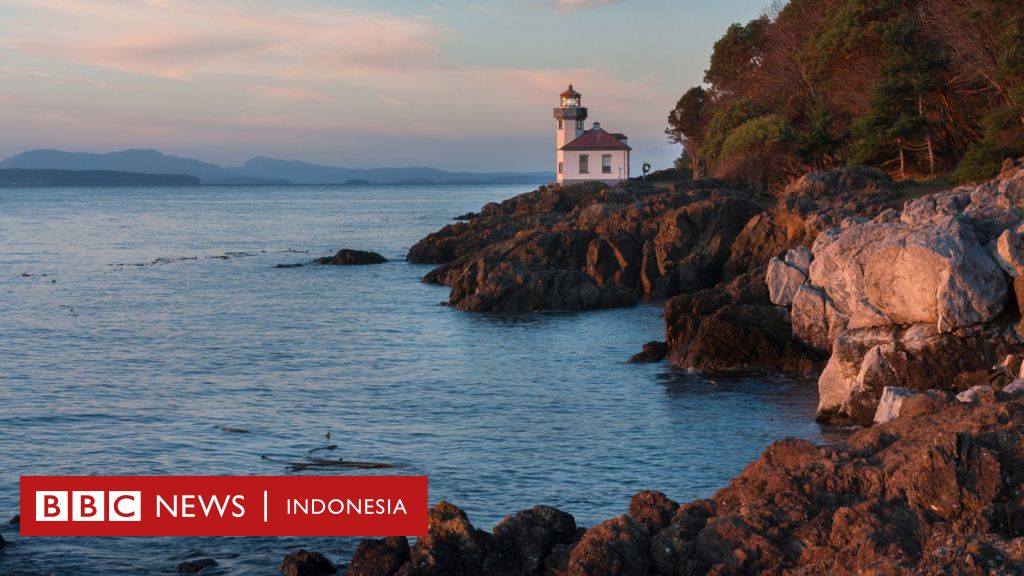Brendan Sainsbury’sBBC Travel
image sources, Edmund Lowe Photography/Getty Images
On San Juan Island in Washington state, a national historic park recalls a border dispute in 1859, when Britain and America nearly went to war over a pig.
Dotted with vast fields and secluded lumber yards, San Juan Island – the second largest of the San Juan Islands in northwestern Washington State – is a place of calm and relaxation.
Killer whales swim in the waters around and off the south coast of Vancouver Island, Canada, located less than seven miles to the west. It’s hard to believe that in this remote corner of the United States, in 1859, Britain and America nearly went to war over a slaughtered pig.
The problem stems from a border dispute.
In 1846, the Oregon Treaty established the 49th parallel as the official boundary between British and American territories in the Pacific Northwest.
However, in the treaty, there was an exception for Vancouver Island, which, despite being on the 49th parallel, was allowed to remain British territory.
In this exception, according to the wording of the agreement, the boundary line is defined as “the central part of the waterway separating the mainland from Vancouver Island”.
But because the waters of the Salish Sea contain many islets and several different channels, no agreement has been reached on the actual boundaries.
Following the occupation of territory claimed by both countries, San Juan Island suddenly found itself at the center of a serious diplomatic crisis.
“War of the Pigs”
Few things would disturb the peace of this place nearly two centuries later, as I pedaled south on a rental bike from the island’s only village, Friday Harbor.
It was a hot, sweltering day in July and I was on my way to Camp America, part of national historical park which is dedicated to the so-called “Pig Wars”.
A few weeks earlier the park had opened a new visitor center and I was curious how the unfortunate death of a wild boar had nearly sparked an international conflict.
image sources, Brendan Sainsbury
There were dozens of buildings at Camp America; only three remain, including the officers’ quarters.
The American camp was located at the southernmost point of the island, six miles south of Friday Harbor, on a smooth, undulating road through heavily hedged farmland.
Ranches were first established on San Juan Island in 1853 when the British-run Hudson’s Bay Company established Belle Vue Sheep Farm in an attempt to gain a foothold in the area and thwart rival American claims to the San Juan Islands.
As the business became profitable, the Americans decided they wanted in too, and within five years dozens of American settlers had left the continent to claim grazing rights – the registration of rights that the British considered illegal.
Tensions had simmered below the surface until June 15, 1859, when an angry American settler named Lyman Cutlar shot a pig he had found feeding in his backyard.
The animal turned out to belong to the British, who had become so outraged by the incident that they threatened to evict the American settlers en masse.
The tension is growing
Undeterred, America asked for military protection. Heeding the call, Captain George Pickett (who would later fight for the Confederates in the American Civil War) was sent to the island, landing with a force of 64 men near Camp America on July 27.
The British responded by sending three warships to the area, as Pickett increased his force to 450 men.
The British then began to conduct military exercises on San Juan Island. The drills are taking place as ships, guns and marines face off amid heightened military tensions.
Back in the peaceful present, I glide over to Camp America and pause to admire the opulent new wood and glass visitor center.
Outside, graphic panels display maps and designs of local indigenous tribes, while inside, images and stories describe a timeline of crises, from Cutlar’s fatal shooting to the brink of conflict.
So how close were the two great powers to almost reaching the point of war?
image sources, Brendan Sainsbury
This graphic board was placed at Camp America to explain the history that took place there.
“Very close,” said park ranger Cyrus Forman.
“Governor James Douglas, Royal Authority in British Columbia, ordered the Royal Navy to fire on all Americans reinforcing George Pickett’s initial troop. Capt. [Inggris] James Prevost had doubts about carrying out the order and finally hesitated when he saw the Americans disembarking.”
When news of the “Pig Wars” reached Washington DC in October 1859, President Buchanan sent high-ranking emissaries on a long journey west to try to end the strife.
prevent war
Their arrival helped defuse tensions quickly, and military action was eventually avoided in favor of a truce.
“There are two people who are considered the most successful in preventing war,” Forman explained.
“Admiral Lambert Baynes, Commander of the Royal Naval Forces in the Pacific, who refused to engage in hostilities despite intense pressure from Governor Douglas and the British Columbia Legislature; and General Winfield Scott, who traveled from New York to the San Juan Islands, where he entered into a Joint Occupation Agreement that allowed both sides to peacefully occupy San Juan Island for 12 years while the process diplomatic progress.
image sources, Brendan Sainsbury
The visitor center includes exhibits about the native peoples of the Island’s Coast Salish.
Tell a story
Opened in June 2022, the visitor center vividly depicts the conflict while reframing its historical context.
Over the years, the popular ‘War of the Pigs’ narrative has emphasized the animosity between the British and the Americans, but failed to acknowledge another important part of the story: namely the lives indigenous peoples of the Island’s Coast Salish who inhabited the Pacific Northwest for thousands of years before the arrival of European settlers.
The arbitrary borders that crossed their lands during the crisis, displacing indigenous tribes and having a major impact on their culture and livelihoods.
This new exhibit features detailed murals depicting scenes of Coast Salish life before the arrival of European settlers and a canoe beautiful natives hung from the ceiling, the work of Lummi Nation sculptor Dean Washington.
“Our goal was to create an installation worthy of this extraordinarily special place – honoring the cultural richness past, present and future,” says Elexis Fredy, manager of the park, new designs and exhibitions department at the centre.
“From the start of the project, we were committed to ensuring that all the nuance and complexity of the park was reflected.”
The project was planned in direct collaboration with the Coast Salish tribes, and seven ornately decorated canoe paddles, each from a different tribe, are displayed in front of the mural.
The joint occupation of San Juan Island lasted from 1859 to 1872, during which time British and American troops coexisted peacefully in separate camps at either end of the island. The relationship between them quickly turned from cold to friendly.
image sources, Atlantis Fototravel/Getty Images
Located on the northwest coast of the island, the British Camp has a typical garden of the country.
Leaving the Visitor Center, I explore Camp America and the remains of a military base that traces its roots to the Armistice of 1859. Dozens of buildings once stood on the site. There are only three left.
Cruising on a clear, windswept road through rolling prairie trails, I passed two former officers’ quarters surrounded by white picket fences and gazed out across Canada across Haro Strait, once controversial.
Although there are few physical reminders of the campground, a series of strategically placed signs help bring the story to life.
There is a trail up to the fort to the south and other trails that extend to the beach, cliffs and lighthouse. Unlike the rest of the island, the park has an unusual scrub ecosystem and is home to the only population Island Marble Butterfly which is very rare.
After I finished walking, I cycled 13 miles along the winding coastal road to British Camp, located on the northwest coast of the island.
Located next to a sheltered cove and surrounded by forest, the landscape contrasts sharply with the open plains of Camp America.
Of the two bases, the British Camp is considered the more luxurious. The officers were stationed in pretty wooden houses on the hillside, with a typical English garden below.
The residence is long gone, but the gardens remain, along with a small bastion and white clapboard barrack buildings.
A military road once connected the two camps, which the local trail committee is currently trying to revive.
After 1859, America and Britain negotiated for more than a decade to find a satisfactory solution to their border disputes.
“Ultimately, they decided that given the severity of their position, they needed binding arbitration conducted by a neutral arbitrator,” Forman told me.
Kaiser Wilhelm of Germany was hired as an arbitrator and asked to choose between two different sea routes as a potential border: the American-favored Haro Strait or the British-favored Rosario Strait.
Eventually, he voted in favor of Haro Strait, and in September 1872, British marines packed up as San Juan Island and its neighboring islands ceded peacefully to the United States.
image sources, Brendan Sainsbury
In 1872, the British left San Juan Island and the diplomatic crisis ended.
As I prepared to return to Friday Harbor, I saw the British camp with the Union flag still flying.
Today, 150 years after the dispute was settled in 1872, it is easy to trivialize a “conflict” whose only victims are pigs. But if war breaks out, the overall costs for both countries can be enormous.
Thankfully, that didn’t happen, and today San Juan Island Historical Park is a reminder that wars, even those started by farm animals, were preventable.

“Amateur problem solver. Hipster-friendly alcohol lover. Beer buff. Infuriatingly humble tv geek.”






